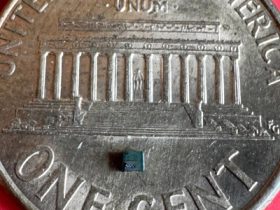The wildly ambitious Golden Dome missile-defense vision is turning up the heat on a long-running fight between the Pentagon and the telecommunications industry for control of certain radio frequencies.
“That area of the spectrum is golden, and we need to protect it to maintain national security. And I use the word golden specifically, because the only way we can achieve Golden Dome” is by using frequencies around 3 gigahertz, Katie Arrington, who is performing the duties of the Pentagon chief information officer, told lawmakers Thursday at a hearing of the House Armed Services’ panel on cyber, information technologies, and innovation. “It is critical for national security.”
Though Golden Dome would use novel space-based sensors, it would also rely on ground-based radars that often use the S and L bands of the electromagnetic spectrum. For example, the Navy’s Aegis Combat System uses the S-band: the frequencies from 2 to 4 gigahertz. But these are the bands that telecommunications companies want to use to expand their 5G and 6G networks.
“That’s a frequency range where you get a good combination of precision and reach. Because if you go to higher frequencies, you don’t see as far because of attenuation. And if you go to lower frequencies, the precision and the resolution of the radar is not as good, so it’s hard to track small things that are going fast,” Bryan Clark, senior fellow and director of the Hudson Institute’s Center for Defense Concepts and Technology, told Defense One. “Most of our air defense radars operate in this 3 to 3.2 gigahertz range. And so we would have to put a bunch of these radars [across] the United States as a part of Golden Dome. The problem is that’s also the frequency range where a lot of cell phone carriers would love to put more 5G infrastructure. Because just like it’s good for radars, it’s also good for 5G.”
Right now, on the coastlines, cellphone carriers have arrangements with the military to vacate parts of the spectrum when a radar is in use. The challenge is that those arrangements would have to become commonplace across the country to make Golden Dome a reality.
“Because we have all of these Aegis radars on ships, they have this spectrum sharing arrangement set up where when somebody turns on their Aegis radar, the cell phone carriers, the network operators, have to shift to a different frequency and get out of the way,” Clark said.
“You’d have to do that same thing in the interior of the country, where, right now, [telecom companies] want to allocate more of those frequencies to 5G, so there’d be more spectrum sharing, which imposes costs on the carrier. They have to figure out how to move to other frequency bands.”
It’s a long-running debate that pits increased consumer demand for next-generation networks against national security concerns.
The squabble began in 2020 when the Federal Communications Commission granted Ligado license to use the L-band, to which DOD and the National Telecommunication and Information Administration objected. That led to a congressionally-mandated report to evaluate whether Ligado’s systems would interfere with GPS and other satellite services. The National Academies of Sciences’ 2022 report found that most commercial GPS systems would not experience harmful interference, but some exquisite ones like those used in surveying, farming, and some defense applications could lose performance or stop working. Moreover, some of the satellite services the Defense Department used “will experience harmful interference on their downlink caused by Ligado user terminals operating in the UL1 band,” according to a 2023 analysis of interference issues.
The Pentagon’s heavily redacted 2023 report on spectrum-sharing concluded “sharing of the 3100-3450 MHz band between federal [U.S. government] and commercial systems is not feasible unless certain regulatory, technological, and resourcing conditions are proven and implemented as part of a coordination framework.”
Ligado Networks sued the Defense Department in 2023 for $39 billion over claims the government unlawfully seized parts of the L-band spectrum the company was using. The company, which filed for bankruptcy in January, originally planned to expand its 5G offerings in that area of the spectrum, but the Pentagon blocked the move, citing potential GPS disruptions.
The matter is complicated further by politics. The impending budget reconciliation bill aims to raise $88 billion by restoring the FCC’s ability to auction off parts of the spectrum, using the funds to cover deficits or fund other initiatives.
Republicans on the Senate Armed Services Committee have been negotiating an agreement with the Senate Commerce, Science and Transportation Committee that would free up some of the wireless spectrum for auction and still protect the parts DOD uses.
But defense hawks on both sides of the aisle have raised concerns about selling off spectrum the military relies on.
In a May 6 letter to the defense secretary, Sen. Maria Cantwell, D-Wash., warned that spectrum auctions would imperil the administration’s Golden Dome efforts.
“This advanced missile defense system relies on a fusion of ground, air, and space-based sensors and radars paired with a variety of kill vehicles to protect us from a broad array of missile threats, including next-generation hypersonic missiles,” wrote Cantwell, who is the ranking member of the Senate commerce committee. “These sensors, radars, and counter-ballistic systems require significant spectrum resources. If Golden Dome remains a priority for the Administration, we need assurances that taking spectrum away from the Department of Defense will in no way impede or delay the effectiveness of this initiative.”
But Republicans seem to be split on the matter. Sen. Ted Cruz, R-Texas, who chairs the Senate commerce committee, has been pushing for the spectrum auction authority because of its potential to generate billions of dollars in revenue. Cruz has argued that not selling off parts of the spectrum could mean missing out on additional resources for the military.
“If DOD is technically unable to operate alongside wireless carriers using these bands domestically, how on earth could we expect to prevail in a Pacific conflict? It simply is not credible. There are also significant opportunity costs for our national defense in delaying spectrum auctions. A pipeline would be lucrative, raising $100 billion or more that could go directly to rebuilding our military to funding border security and to financing Coast Guard polar icebreakers,” Cruz said during a Feb. 19 hearing.
He also accused Pentagon staffers of lobbying Congress to vote down legislation that would reinstate the FCC’s auctioning ability, according to a March 25 letter to Defense Secretary Pete Hegseth.
Sen. Mike Rounds, R-S.D., has said he’d vote down any bill that allowed the 3.1-3.45 gigahertz part of the spectrum to be auctioned off.
“Many of our military’s most important radar systems operate on the 3.1-3.45 gigahertz (GHz) band of the spectrum, referred to as the lower-3 band,” Rounds wrote in an op-ed. “Forcing the DOD to vacate or share those portions of the spectrum would cost taxpayers dearly—the Navy alone estimates that it would cost them $250 billion to migrate their systems to other bands of the spectrum, and that would take time we do not have with the looming threat of a belligerent Communist China.”
On Thursday, Rep. Don Bacon, R-Neb., who chairs the HASC CITI subcommittee, said it’s important to understand which parts of the spectrum can be shared with industry and others that “we cannot trade off.”
“I can’t tell you how important it is to us knowing that, yes, there’s some areas we can maybe work on with the industry. There’s areas that we cannot trade off. And I just know many of us on the Armed Services Committee are going to be the best stewards we know how to protect our national security here,” he said.
Ultimately, it’s still a technical problem, one that’s solvable with existing commercial technologies, Clark told senators in the February hearing. But the trick is getting companies to find an arrangement that balances commercial costs and protecting the Defense Department’s spectrum access.
“Spectrum sharing schemes could allow the U.S. government to protect its military operations and support commercial uses, but companies and U.S. policymakers should ensure they account for the associated costs and complexity,” he wrote in submitted testimony. “The challenge for regulators and Congress will be creating spectrum sharing schemes that protect necessary DOD access while remaining financially attractive for the telecommunications industry.”
The Pentagon is working on a dynamic spectrum-sharing solution that could alleviate interference concerns, but “that is yet to be determined,” Arrington said.
“We do need to look at ways to share [spectrum] in a sensible, realistic manner,” she said. “We’re really looking to our study on DSS—dynamic spectrum sharing. But the president has made it crystal clear that we are to protect the nation first.”
Read the full article here








Leave a Reply